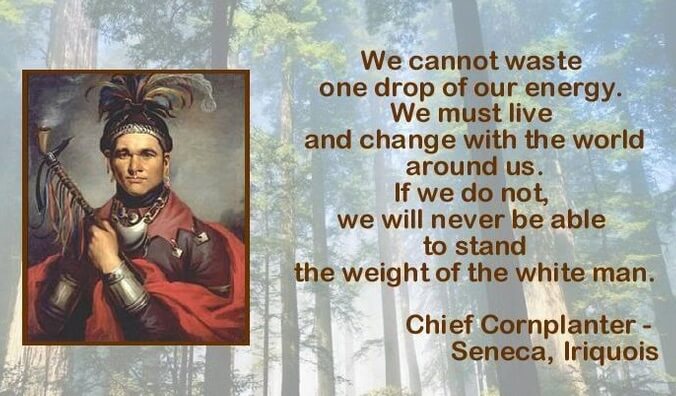To view this page in another language, please click here:
Other Languages
Chief Cornplanter
(GY-ANT-WA-CHIA)
The Last War Chief of the Senecas
Chief Cornplanter, or "the corn planter" to the Senecas,
was born in the little town of Conewaugus on the Genessee River in New
York state. Although the exact date of his birth is not known, it was
somewhere between the years 1732 and 1740. Cornplanter was a half
breed, the son of a white man and an Indian royaneh, a memeber of a
Seneca noble family and a hereditary matron of the Wolf clan. There has
always been some question as to whether his father was an Englishman,
John O'Bail, or a Dutch trader, John O'beel or Abeel. It is most
probable that the latter is correct. At any rate, his father hailed
from the Mohawk Valley.
Cornplanter's English name came down as John O'Bail. He was
the earliest settler in Warren County, Pennsylvania, and a contemporary
of George Washington. They became close friends during the
Revolutionary War. Cornplanter was often referred to as one of the most
valiant warriors of his tribe, of superior sagacity and eloquence. He
first fought with the British during the war as chief of the Seneca
Nation, but when his people were deserted by their British allies he
took part in Indian treaties with the American government. For his help
during the ensuing Indian war he was given land in several locations.
In 1789 the recommendation was made that Chief Cornplanter
be given a grant of 1500 acres of land in western Pennsylvania. By act
of the Pennsylvania assembly passed February 1, 1791, he was granted
lands for which the patents were issued March 16, 1796. The final gift,
an area of about 700 acres, was the Cornplanter Grant, located in
Warren County about three miles below the southern boundary of New York
state. There were three separate units in this grant, Planter's Field
and the town of Jennesedaga on the mainland along the Allegheny River,
and two adjacent islands, Liberality and Donation. This land was a
partial recognition to Cornplanter for his services to the state, and
he settled on the grant with his family, remaining there until his
death in 1836. Chief Cornplanter was awarded the distinction of a
biography in the "Encyclopedia Britanica" as one of Warren County's two
most famous men.
Above information from Quo
Vadis Bed and Breakfast in Franklin, PA "In the summer of 1779, Brant
along with Butler's Rangers, units of the British Army from Ft.
Niagara, and war parties from the Seneca, Mohawk, Onondaga, and Mingos
attempted to stop the rebel Brigadier General Sullivan. Sullivan had
been sent to destroy Iroquois villages by General Washington as
reprisal for Indian and Loyalist raids. Unable to stop this army of
5000 men Brant, Old Smoke, Corn Planter and Lt. Colonel John Butler
fought a desperate delaying action in order to allow the escape of many
refugees, both Native and non-Native."
The First signature on the DEED
from the six nations of indians to the state of Pennsylvania,
January 9, 1789, is:
and again, on ARTICLES
OF AGREEMENT between the chiefs, etc., of the six nations of indians and the commissioners of Pennsylvania,
January 9, 1789, the First
signature is
Cornplanter
Forest District in Forest County, PA, is "named in honor of Chief
Corn Planter, a famous Indian Chief of the Seneca tribe. He was
instrumental in maintaining peace between the new American government
and the League of the Iroquois between 1784 and 1812."
And a final bit of curious information:
A "Sterling Berry Spoon" with Chief Corn Planter's image engraved
thereon sold for $135.00 on 2 March 2001, at Chadwick Bay
Auction House.
Iroquois Confederacy and
the US Constitution
John Abeel (ca. 1752 - February 18, 1836), known as Gaiant'wake (Gyantwachia - "the planter") or Kaiiontwa'kon (Kaintwakon -
"By What One Plants") in the Seneca language and thus generally known as Cornplanter, was a Seneca war chief and diplomat.
As a chief warrior, Cornplanter fought in the French and Indian War and the American Revolutionary War. In both wars, the
Seneca and three other Iroquois nations were allied with the British. After the war Cornplanter led negotiations with the
United States and was a signatory of the Treaty of Fort Stanwix (1784). He helped gain Iroquois neutrality during the Northwest Indian War.
In the postwar years, he worked to learn more about European-American ways and invited Quakers to establish schools
in Seneca territory. Disillusioned by his people's poor reaction to European-American society, he had the schools closed
and followed his half-brother Handsome Lake's movement returning to traditional Seneca way. The United States government
granted him about 1500 acres of former Seneca territory in Pennsylvania in 1796 for "him and his heirs forever", which became
known as the Cornplanter Tract. It was flooded in 1965 by the Kinzua Dam, and most of the remaining residents were relocated to
the Allegany Reservation of the federally recognized Seneca Nation of New York.
Compiled by: Glenn Welker
This site has been accessed 10,000,000 times since February 8, 1996.
who have a Chief Corn Planter Room!
![]() Return to Indigenous Peoples' Literature
Return to Indigenous Peoples' Literature
ghwelker@gmx.com

